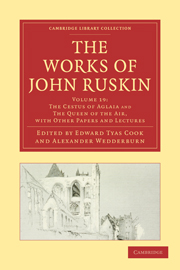Book contents
- Frontmatter
- Contents
- LIST OF ILLUSTRATIONS
- INTRODUCTION TO THIS VOLUME
- PART I “SIR JOSHUA AND HOLBEIN” (1860)
- PART II “THE STUDY OF ARCHITECTURE IN SCHOOLS” (1865)
- PART III “THE CESTUS OF AGLAIA” (1865, 1866)
- PART IV “THE RELATION OF NATIONAL ETHICS TO NATIONAL ARTS,” BEING THE REDE LECTURE FOR 1867
- PART V “ON THE PRESENT STATE OF MODERN ART, WITH REFERENCE TO THE ADVISABLE ARRANGEMENT OF A NATIONAL GALLERY” (1867)
- PART VI “FAIRY STORIES”: A PREFACE TO “GERMAN POPULAR STORIES” (1868)
- PART VII “THE FLAMBOYANT ARCHITECTURE OF THE VALLEY OF THE SOMME” (1869)
- PART VIII “THE QUEEN OF THE AIR” (1869)
- PART IX “VERONA, AND ITS RIVERS” (1870)
- APPENDIX: REPORTS OF ADDRESSES ON ART
- I ARCHITECTURE IN FRANCE (186l)
- II COMPETITION AND MECHANICAL ART (1865)
- III THE THREE-LEGGED STOOL OF ART (1868)
- Plate section
III - THE THREE-LEGGED STOOL OF ART (1868)
Published online by Cambridge University Press: 05 November 2011
- Frontmatter
- Contents
- LIST OF ILLUSTRATIONS
- INTRODUCTION TO THIS VOLUME
- PART I “SIR JOSHUA AND HOLBEIN” (1860)
- PART II “THE STUDY OF ARCHITECTURE IN SCHOOLS” (1865)
- PART III “THE CESTUS OF AGLAIA” (1865, 1866)
- PART IV “THE RELATION OF NATIONAL ETHICS TO NATIONAL ARTS,” BEING THE REDE LECTURE FOR 1867
- PART V “ON THE PRESENT STATE OF MODERN ART, WITH REFERENCE TO THE ADVISABLE ARRANGEMENT OF A NATIONAL GALLERY” (1867)
- PART VI “FAIRY STORIES”: A PREFACE TO “GERMAN POPULAR STORIES” (1868)
- PART VII “THE FLAMBOYANT ARCHITECTURE OF THE VALLEY OF THE SOMME” (1869)
- PART VIII “THE QUEEN OF THE AIR” (1869)
- PART IX “VERONA, AND ITS RIVERS” (1870)
- APPENDIX: REPORTS OF ADDRESSES ON ART
- I ARCHITECTURE IN FRANCE (186l)
- II COMPETITION AND MECHANICAL ART (1865)
- III THE THREE-LEGGED STOOL OF ART (1868)
- Plate section
Summary
Mr. Ruskin addressed the students, complimenting them with discrimination on the progress which they had made in the study of art. He had watched the progress of the school, and regretted that he had not been able to devote more time and attention to giving advice and assistance when required of him. Agreeing to some extent with the opinion of the hon. chairman as to the lesson to be learned from the useful and agreeable refreshment room of a railway station, he could not but think that art was misplaced when applied to a place where everybody was in a hurry. He thought art itself should, however, be refreshing in its character, no matter under what circumstances it was applied. Art should be run after open-eyed, not open-mouthed. The most beautiful works of art were always done in youth, and he advised those who heard him to do whatever they did with hearty goodwill, and with an endeavour to make it faultless. He advised them to study carefully what he called “the three-legged stool of art”—viz., form, shade, and colour. If they worked and studied earnestly, they must live on bread and water during their early days, but they would in the end feed upon ambrosia.
- Type
- Chapter
- Information
- The Works of John Ruskin , pp. 469Publisher: Cambridge University PressPrint publication year: 2010First published in: 1905



